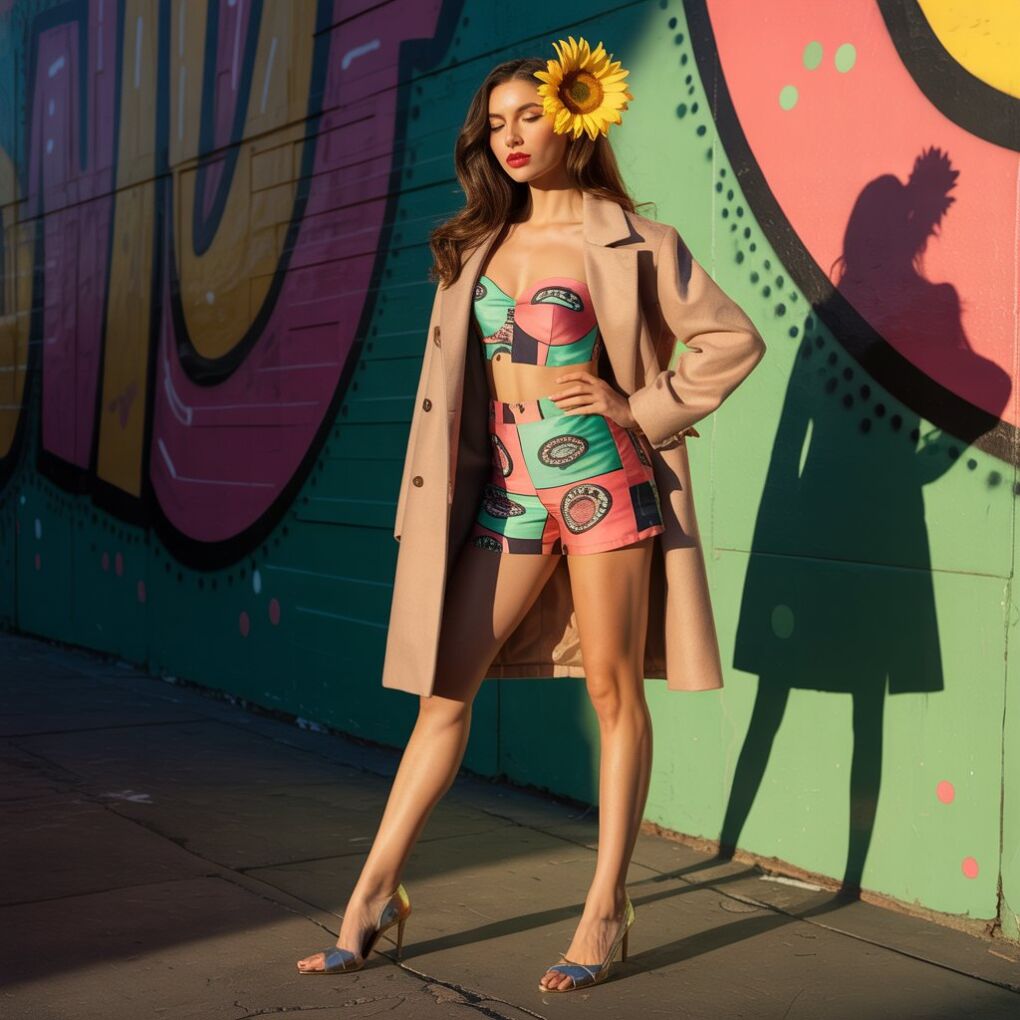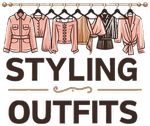Kitsch fashion isn’t just clothing; it’s a vibrant declaration of joy, irony, and nostalgia. Imagine clashing bold prints, cartoonish motifs, and over-the-top accessories colliding in a glorious celebration of the “bad taste” turned brilliant. Once dismissed as tacky, kitsch has stormed back as a powerful playful style movement, championing maximalism, individuality, and a wink-wink nod to pop culture absurdity. It’s fashion that refuses to take itself seriously, inviting you to revel in the ridiculous and find beauty in the bizarre. Ready to dive into this technicolor rabbit hole? Let’s unravel the charm of dressing delightfully “wrong.”

What Exactly is Kitsch Fashion? Defining the Deliberately “Bad”
Kitsch fashion deliberately embraces elements traditionally deemed gaudy, tacky, or culturally lowbrow – think plastic jewelry, neon colors, cartoon characters on adult clothing, or excessive ruffles. It thrives on exaggeration, irony, and a playful rejection of minimalist “good taste.” Unlike accidental fashion mishaps, kitsch is intentional. It’s about reclaiming the ostentatious with a knowing smile.
This eclectic fashion style often borrows from nostalgic sources like 80s cartoons, 50s diner culture, or 70s psychedelia, remixing them into audacious modern statements. The wearer isn’t oblivious; they’re in on the joke, celebrating the very essence of cultural excess. Kitsch challenges fashion elitism, asking: Who decides what’s “tasteful” anyway?
From Trash to Treasure: A Brief History of Kitsch
The term “kitsch” originated in 19th-century Germany, describing cheap, sentimental art sold to the newly affluent middle class. By the mid-20th century, intellectuals like Clement Greenberg condemned kitsch as art’s crass opposite. Yet, post-war pop culture began flipping the script. Andy Warhol’s soup cans and Roy Lichtenstein’s comic panels blurred high/low art boundaries, paving the way for kitsch’s re-evaluation.
In fashion, designers like Elio Fiorucci (with his playful jeans and cartoon graphics) and Betsey Johnson (with her punk-inflected tutus and neon) injected kitsch sensibilities into the mainstream during the 70s and 80s. The 90s and 2000s saw ironic t-shirts and vintage clothing revivals, turning thrift-store finds into statement pieces. Today, social media accelerates kitsch’s cycle, transforming yesterday’s “cringe” into today’s coveted nostalgic fashion.
Kitsch vs. Camp: Untangling the Aesthetic Twins
While often used interchangeably, kitsch and camp aesthetic are distinct siblings. Susan Sontag’s seminal 1964 essay “Notes on Camp” defined camp as love for the unnatural, exaggerated, and earnestly over-the-top – think drag queens or Baroque opera. Camp is extravagant sincerity.
Kitsch, however, leans into irony. It’s the knowing use of “cheap” aesthetics. A kitsch fashion outfit might pair a Homer Simpson sweater with leopard-print pants – it’s absurd and deliberately so. Camp worships excess with devotion; kitsch deploys it with a sly grin. Both reject minimalism, but their emotional cores differ: camp is heartfelt, kitsch is cheeky.
The Essential Ingredients of a Kitsch Wardrobe
Building a kitsch look means embracing chaos with confidence. Key elements include:
- Bold Prints & Clashing Patterns: Polka dots, animal prints, florals, and cartoon graphics – all worn together.
- Nostalgic References: Logos from 90s snacks, cartoon characters, retro tech motifs (think floppy disks or cassette tapes).
- Exaggerated Silhouettes: Puff sleeves, bubble hems, ultra-wide legs, or extreme mini skirts.
- Plastic & Novelty Fabrics: Vinyl, sequins, faux fur, and intentionally “cheap”-looking synthetics.
- Over-the-Top Accessories: Giant plastic earrings, charm bracelets piled high, light-up sneakers, kitschy handbags (like a burger-shaped clutch).
The magic lies in the mix. A kitsch outfit isn’t one novelty item paired with basics – it’s a full sensory overload!
Why We Crave Kitsch: The Nostalgia Connection
Nostalgic fashion is kitsch’s beating heart. Kitsch taps into collective cultural memory, evoking childhood toys, Saturday morning cartoons, or grandma’s “tacky” knick-knacks. Psychologically, this nostalgia offers comfort and identity in chaotic times. Wearing a Power Rangers t-shirt or earrings shaped like 90s lip gloss isn’t just ironic; it’s a tactile connection to simpler, playful moments.
Brands like Simone Rocha (incorporating childlike pearls and tulle) or MSCHF (with their viral “Big Red Boots”) leverage this powerfully. Kitsch allows adults to reclaim joy and whimsy, rejecting the pressure to constantly appear “sophisticated.” It’s fashion as emotional time travel.
Mastering the Mix: How to Wear Kitsch Without Looking Costumed
Pulling off kitsch fashion requires balancing chaos with intention. Follow these playful style rules:
- Anchor with Neutrals (Sometimes): Pair a wildly printed kitsch skirt with a simple black top. Let one piece dominate.
- Play with Scale: Combine large-scale patterns (giant strawberries) with smaller ones (tiny gingham).
- Focus on Quality: A well-cut, intentionally kitschy dress reads fashion-forward, not cheap.
- Edit Your Accessories: Don’t wear every novelty item at once. Choose 1-2 over-the-top accessories as focal points.
“Kitsch is the absolute mastery of the ridiculous. It’s not about wearing a joke; it’s about becoming the punchline with utter confidence.” – Anonymous Fashion Stylist
Icons of Excess: Kitsch Fashion Trailblazers
Certain designers and celebrities embody kitsch’s spirit:
- Betsey Johnson: The undisputed queen, known for cartwheels, pink hair, and designs bursting with neon, sequins, and tutus.
- Jeremy Scott (Moschino): His fast-food logos, Barbie collabs, and paper-doll dresses epitomize high-fashion kitsch.
- Anna Dello Russo: The editor famed for wearing head-to-toe thematic extravagance, like giant teddy bear backpacks.
- Lil Nas X & Doja Cat: Modern pop stars embracing kitsch in music videos and red carpets (think cowboy-meets-space-opera aesthetics).
These icons prove kitsch isn’t fringe; it’s a powerful, joyful language.
Kitsch Takes the Spotlight: Pop Culture’s Love Affair
Kitsch saturates pop culture, shaping how we see fashion on screen and in music:
- Film & TV: Clueless (plaid, fluffy pens), The Fifth Element (Leeloo’s bandages), Euphoria (Maddy’s hyper-feminine, retro looks).
- Music: Lady Gaga’s meat dress, Katy Perry’s cupcake bras, K-Pop’s embrace of colorful maximalism (like aespa’s hyper-digital outfits).
- Social Media: TikTok’s “Ugly Chic” and “Cluttercore” trends celebrate kitsch aesthetics in home decor and fashion, fueling its revival.
This mainstream visibility validates kitsch as a legitimate, influential force.
| Kitsch Theme | Key Elements | Modern Example |
|---|---|---|
| Retro Toybox | Primary colors, plastic textures, cartoon graphics | Crocs with Jibbitz™ charms, Lazy Oaf Mickey Mouse knits |
| Grandma’s Attic | Ditsy florals, lace, doilies, porcelain motifs | Simone Rocha pearl-embellished bags, cottagecore aprons |
| Cyber Y2K | Futuristic metallics, pixel glitches, tech logos | Coperni’s tech-infused dresses, Area’s circuit board jewelry |
| Maximalist Clash | Animal print + florals + stripes, excessive layering | Gucci’s Alessandro Michele era, Matches Fashion editorials |
More Than Just Fun: The Psychology of Dressing Kitsch
Choosing kitsch fashion is a psychological act:
- Defiance: It rejects minimalist norms and fashion elitism.
- Authenticity: It signals comfort with not being “serious” or conventionally tasteful.
- Joy-Seeking: Bright colors, playful motifs, and tactile textures boost mood (color psychology!).
- Irony as Armor: Wearing something knowingly “tacky” can be empowering – it pre-empts criticism.
In a world obsessed with curated perfection, kitsch embraces imperfection and humor as radical self-expression.
Sustainable Kitsch: Thrifting, Vintage & Ethical Maximalism
Kitsch aligns beautifully with sustainable fashion:
- Thrifting & Vintage: The best kitsch pieces are often found in charity shops (old souvenir tees, 80s prom dresses, gaudy jewelry).
- DIY & Upcycling: Transform dated items into kitsch masterpieces (add patches, rhinestones, or dye).
- Supporting Indie Designers: Brands like Lirika Matoshi (strawberry dresses) or Susan Alexandra (beaded bags) create new kitsch ethically.
Pro Tip: Use eBay search filters for “vintage [decade] + [item] + kitsch” (e.g., “vintage 90s cartoon sweater”). Local flea markets are goldmines!
Kitsch for Every Body: Celebrating All Shapes
Kitsch fashion is inherently inclusive – its focus on boldness, not conformity, celebrates all bodies:
- Curvy Figures: Embrace voluminous skirts, loud prints, and corset-inspired tops as statement makers.
- Petite Frames: Opt for bold accessories (large hair clips, chunky boots) to add impactful kitsch without overwhelm.
- Gender Fluidity: Kitsch’s rejection of rules makes it perfect for experimental, non-binary styling.
Focus on pieces that spark joy, regardless of “flattering” conventions. Confidence is the ultimate kitsch accessory.
The Future is Loud: Where Kitsch Fashion is Headed
Kitsch isn’t fading; it’s evolving:
- Digital Kitsch: NFTs and virtual fashion (like digital-only kitsch accessories for avatars).
- Kitsch-Tech Fusion: Glitch prints, LED elements integrated into clothing.
- Hyper-Nostalgia: Zoomer obsession with specific micro-decades (2000s McBling, 2010 Tumblr) fuels new kitsch cycles.
- Luxury Embrace: High-end brands continue collaborating with pop culture IP (Loewe x My Neighbor Totoro).
As society grapples with complexity, kitsch’s joyful rebellion and nostalgic comfort offer a potent antidote.
Further Exploration:
- Read: Susan Sontag’s “Notes on Camp” (PDF)
- Shop: Selkie (modern kitsch dresses), Lucy Folk (playful accessories)
- Follow: @kitschsnitch (Instagram inspiration)
Conclusion: Embrace the Extraordinary Ordinary
Kitsch fashion is a triumphant middle finger to minimalism and a warm hug to nostalgia. It transforms the mundane, the tacky, and the sentimental into statement pieces of radical self-love and humor. By mixing bold prints, donning over-the-top accessories, and channeling retro style with irony, we reclaim fun in fashion. In a world obsessed with scarcity and seriousness, choosing kitsch is an act of joyful resistance. So raid that thrift store, layer those clashing patterns, and wear that pizza-print jacket with pride. Life’s too short for boring clothes.
“Kitsch is the inability to admit that shit exists.” – Milan Kundera (But we say: Kitsch is the courage to make that shit fabulous!).
